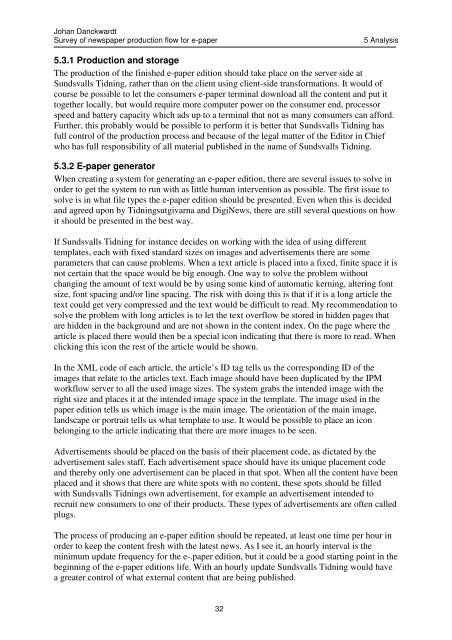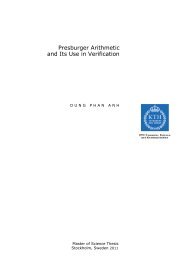Survey of Newspaper Production Flow for E-paper - Kungliga ...
Survey of Newspaper Production Flow for E-paper - Kungliga ...
Survey of Newspaper Production Flow for E-paper - Kungliga ...
Create successful ePaper yourself
Turn your PDF publications into a flip-book with our unique Google optimized e-Paper software.
Johan Danckwardt<br />
<strong>Survey</strong> <strong>of</strong> news<strong>paper</strong> production flow <strong>for</strong> e-<strong>paper</strong> 5 Analysis<br />
5.3.1 <strong>Production</strong> and storage<br />
The production <strong>of</strong> the finished e-<strong>paper</strong> edition should take place on the server side at<br />
Sundsvalls Tidning, rather than on the client using client-side trans<strong>for</strong>mations. It would <strong>of</strong><br />
course be possible to let the consumers e-<strong>paper</strong> terminal download all the content and put it<br />
together locally, but would require more computer power on the consumer end, processor<br />
speed and battery capacity which ads up to a terminal that not as many consumers can af<strong>for</strong>d.<br />
Further, this probably would be possible to per<strong>for</strong>m it is better that Sundsvalls Tidning has<br />
full control <strong>of</strong> the production process and because <strong>of</strong> the legal matter <strong>of</strong> the Editor in Chief<br />
who has full responsibility <strong>of</strong> all material published in the name <strong>of</strong> Sundsvalls Tidning.<br />
5.3.2 E-<strong>paper</strong> generator<br />
When creating a system <strong>for</strong> generating an e-<strong>paper</strong> edition, there are several issues to solve in<br />
order to get the system to run with as little human intervention as possible. The first issue to<br />
solve is in what file types the e-<strong>paper</strong> edition should be presented. Even when this is decided<br />
and agreed upon by Tidningsutgivarna and DigiNews, there are still several questions on how<br />
it should be presented in the best way.<br />
If Sundsvalls Tidning <strong>for</strong> instance decides on working with the idea <strong>of</strong> using different<br />
templates, each with fixed standard sizes on images and advertisements there are some<br />
parameters that can cause problems. When a text article is placed into a fixed, finite space it is<br />
not certain that the space would be big enough. One way to solve the problem without<br />
changing the amount <strong>of</strong> text would be by using some kind <strong>of</strong> automatic kerning, altering font<br />
size, font spacing and/or line spacing. The risk with doing this is that if it is a long article the<br />
text could get very compressed and the text would be difficult to read. My recommendation to<br />
solve the problem with long articles is to let the text overflow be stored in hidden pages that<br />
are hidden in the background and are not shown in the content index. On the page where the<br />
article is placed there would then be a special icon indicating that there is more to read. When<br />
clicking this icon the rest <strong>of</strong> the article would be shown.<br />
In the XML code <strong>of</strong> each article, the article’s ID tag tells us the corresponding ID <strong>of</strong> the<br />
images that relate to the articles text. Each image should have been duplicated by the IPM<br />
workflow server to all the used image sizes. The system grabs the intended image with the<br />
right size and places it at the intended image space in the template. The image used in the<br />
<strong>paper</strong> edition tells us which image is the main image. The orientation <strong>of</strong> the main image,<br />
landscape or portrait tells us what template to use. It would be possible to place an icon<br />
belonging to the article indicating that there are more images to be seen.<br />
Advertisements should be placed on the basis <strong>of</strong> their placement code, as dictated by the<br />
advertisement sales staff. Each advertisement space should have its unique placement code<br />
and thereby only one advertisement can be placed in that spot. When all the content have been<br />
placed and it shows that there are white spots with no content, these spots should be filled<br />
with Sundsvalls Tidnings own advertisement, <strong>for</strong> example an advertisement intended to<br />
recruit new consumers to one <strong>of</strong> their products. These types <strong>of</strong> advertisements are <strong>of</strong>ten called<br />
plugs.<br />
The process <strong>of</strong> producing an e-<strong>paper</strong> edition should be repeated, at least one time per hour in<br />
order to keep the content fresh with the latest news. As I see it, an hourly interval is the<br />
minimum update frequency <strong>for</strong> the e-.<strong>paper</strong> edition, but it could be a good starting point in the<br />
beginning <strong>of</strong> the e-<strong>paper</strong> editions life. With an hourly update Sundsvalls Tidning would have<br />
a greater control <strong>of</strong> what external content that are being published.<br />
32
















